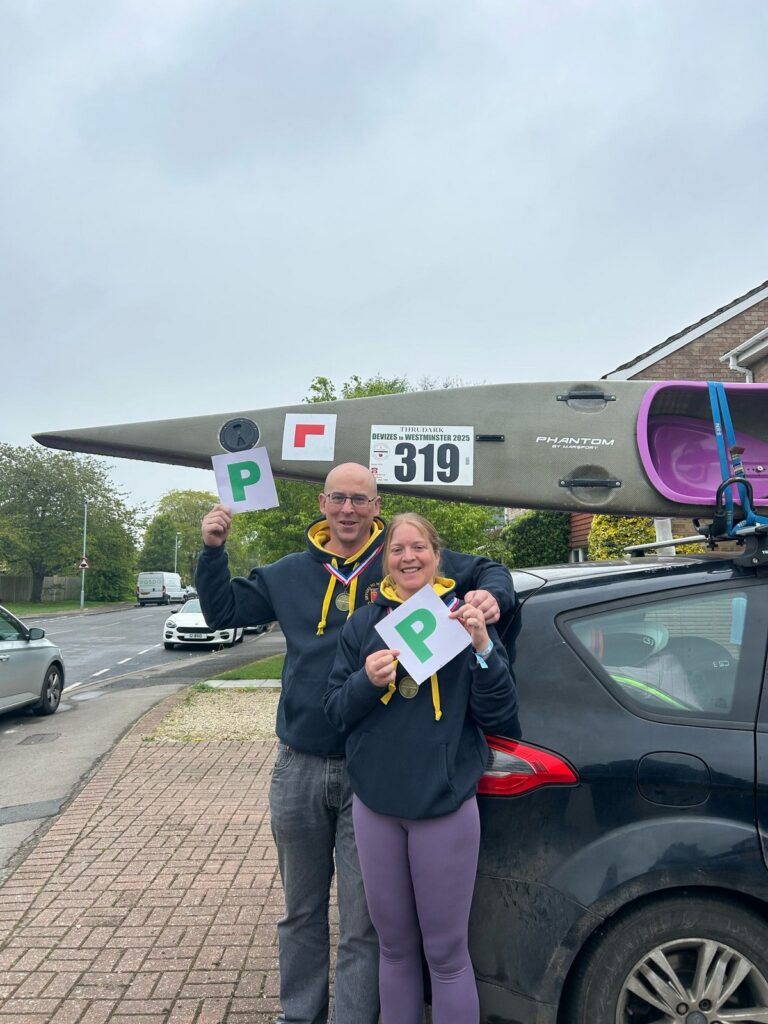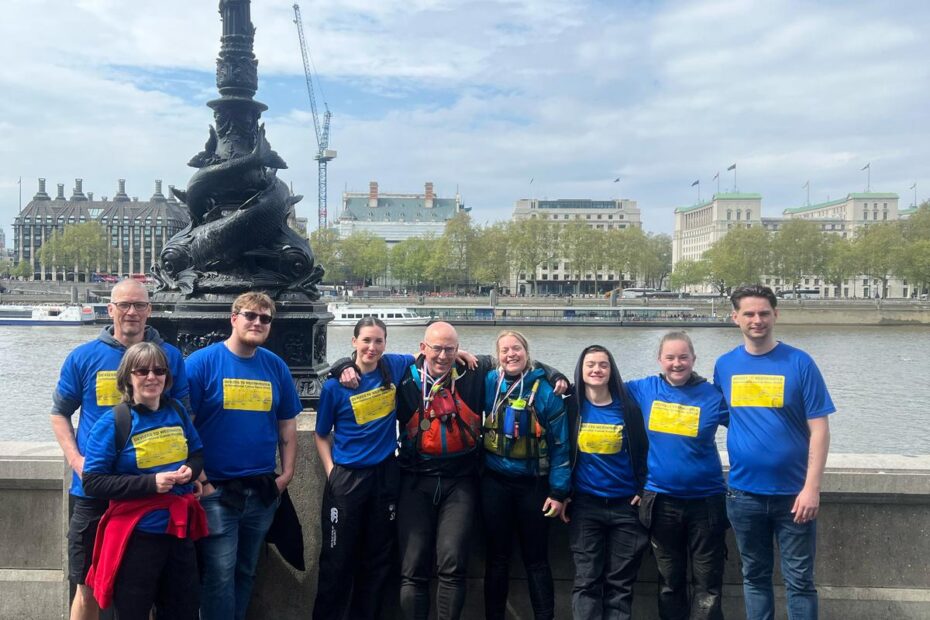Devizes-Westminster Canoe Race 2025 by Tim and Laura
The race had been a long time coming. We first discussed the idea of entering in August and started training in earnest in September ’24 after we managed to get hold of a suitable boat. Since then, we’ve generally been on the water around three times a week, paddling varying rivers and canals to give us the best possible chance of gaining acceptance into the race and accomplishing the dream of becoming successful ‘DWers’. Given both of us have family and work commitments, we were normally on the water between 0500 and 0700 – who knew that there are actually two 4 o’clocks in every day? At the weekends, whenever possible, we’d get in a longer paddle, somewhere between 20 and 50 miles.
As two sea kayakers, the challenge to turn into racing paddlers was on. Besides the physical preparation, there was a lot of logistics to consider, and we were exceptionally lucky with this in two regards. Firstly, Dave Brown – an excellent paddler with a wealth of experience – took us under his wing and coached us on everything from paddling technique through to equipment, nutrition and race strategy, he also introduced us to Runcorn Canoe Club who specialise in kayak racing, and they were also an invaluable source of essential information.

Secondly, we had an awesome support team – seven people in total – led by the redoubtable Abi Beck. These guys did an amazing job making sure that we were warm and dry, well fed, hydrated, medicated and that our morale was kept high. Without the support we received from both groups, it’s doubtful we would have started the race, let alone completed it. We are eternally grateful.

On the day of the race, we woke to breezy, drizzly conditions. Although the rain was due to stop by midday, the strong and gusty easterly wind was going to be in our faces until we finished. We started out at 7 am and soon chalked up our first victory – passing the Angry Swan at Devizes Wharf. This may sound trivial, but our training runs on various canals and rivers had given us a healthy respect for these irascible devil-birds. Although (to the best of our knowledge) nobody was attacked by a swan this year, one crew was forced to retire when a low-flying Canada goose smashed into their boat, capsizing them.
The first 12 miles of the route is shallow canal, and it’s a bit of a slog – helpful advice on how to get through ‘The pound’ from the DW start team ensured our spirits were high and our initial adrenaline combined with excited conversation along the lines of ‘we are here, racing DW, fancy a little paddle this weekend?’, passed the time. Having already completed sections of the course previously on Thameside and Waterside races, we were fast approaching the Bruce tunnel, which is oddly disconcerting in a kayak. We did it (inadvertently) without a head torch and were pleased to tick another obstacle off the list without a swim! Next came the ‘Compton Flight’ – a ‘staircase’ of eight locks, a few hundred meters apart from each other. At each lock, you have to pick your boat up, carry it around the lock and put it back in again. Good paddlers do this with immense speed and impressive grace – we two, not so much! In total, there are 77 such ‘portages’ along the 125-mile route.
We plodded onward, making reasonably good time despite the headwind, through stunning rural countryside, past Hungerford and Kintbury and into Newbury, where we picked up some flow from the river Kennet as it joins the canal. Time passed as we planned future adventures (back in sea boats!) and played the same kind of games you used to keep children entertained on long car journeys. This year, the flow on the river was quite low, which is a mixed blessing: it lowers the likelihood of an unexpected swim as a result of the boat getting thrown about by the current, but it reduces your speed, meaning that you’re paddling for longer, so fatigue becomes more of a problem.
We had been met by our support team at least every five miles, and they had fed us (mainly boiled potatoes and cheese sarnies) and swapped out our drinking bottles at these stops, but around Reading, where the canal runs into the River Thames, we had hot chip butties, which were a big morale boost. As we paddled down the first section of the Thames, dusk turned to dark and we switched our lights on. We knew we were in for a gruelling night ahead, but there was nothing to do but dig in and drive on. It is incredibly eerie when your vision is limited to a few metres in front of the boat, and it’s a real challenge working out which way the river flows in the pitch black, especially when tiredness creeps in. Conversation in the boat grew sparse, but it was a companionable silence.
We made a significant navigational error near Temple Lock, missing the correct route in the dark and taking a detour around the top of the weir, before finding our way back to the main channel. We were growing tired, and this slip-up was bad for morale. We were now significantly behind our planned timings, and things were not looking good. Whilst we still had the possibility of making the ‘tidal window’ at Teddington, it was clear that if we continued to lose time, for us, the race would be over soon, and not in a good way.
Our support team saved the day: hot Lemsip, dry hats, hugs and gentle words of encouragement had us back on the water and moving again. We found our second wind, and we fought on. We were now solidly in ‘Type II Fun’ conditions, neither of us was enjoying it, and the stiff headwind made progress grindingly slow.
Although neither mentioned it at the time for fear of discouraging the other, we were both terrified by the thought of the fast-flowing, choppy water of the tidal Thames, and this weighed on our minds. But there was not a snowball’s chance in hell that either one of us was going to let the other person down. There was no point in worrying about what lay ahead; all that mattered now was to keep the boat moving forward. Dig in! Dig in! Dig in!
It grew light at about 0530, and by the time we reached Teddington, the sun was up. We had made the tidal window, and even had time for porridge and a sausage sarnie before setting off on the final leg, down to Westminster. This was heavenly ambrosia, but even so, it was somehow difficult to stomach as we were both running close to complete exhaustion. Once again, a great support team made all the difference.
We both acknowledged that we were physically broken as we made our way down the tidal section of the river. It seemed interminable, even with the very little flow of the river in our favour. All thought of paddling technique was forgotten, we were satisfied to be putting one paddle in the water at a time, to hell with all else!

It got choppy. We were increasingly having to throw in dramatic support strokes to keep the boat upright. The pilots of the Uber boats were very, very considerate and slowed to a crawl as they passed us. The pilots of the tourist boats were not so careful, and we were amazed that we managed to pass one without going in.
We were on a comparatively flat bit of water when it happened, and neither of us has any explanation of how or why it happened, but one minute we were doggedly paddling, and then the next, we were swimming. Less than two miles to the finish line, and the whole thing had come to bits. Devastating.
But all was not lost! A safety boat came to our aid, and we were soon back in, paddling on – more nervous and twitchier than ever, Laura driving as hard as her exhausted arms and cramped, swollen hands would allow, and Tim in an almost perpetual low-brace behind, maintaining the stability and keeping us both upright. We must have looked quite comical.
We limped passed the finish line – almost deaf to the cheers of our support crew and others at the steps just past the bridge. Strong men in drysuits lifted us from the boat, for we were not in a position to do so ourselves. It was over. We had done it – we could officially claim ourselves as ‘DWers’ and have the medal to prove it!
Again, our support crew were awesome beyond belief, arranging a quick change of clothes in central London, sorting out a couple of celebratory photos, picking up the boat and leading us to cars parked nearby. The paddling might be over, but the support crew were still digging in hard, unable to relax until we were safely off the road.
We were in the race to complete it, rather than to achieve a specific time. We came in at 29 hours and 23 minutes, which put us 34th out of 37 boats which completed the race, out of a total of 75 crews that had set off from Devizes – probably the highest drop-out rate the race has ever seen. The winners took a little over 17 hours, much to our admiration!
So far, we’ve raised £3,292 toward a select few, highly deserving charities. Massive thanks to those of you who have supported us in this. If you haven’t donated, but you’ve enjoyed reading this, and you can afford to, please consider chucking a few quid at our Just Giving page (https://www.justgiving.com/crowdfunding/tim-laura-dw-2025?utm_medium=CR&utm_source=CL).
Paddle safely!
Laura & Tim.

